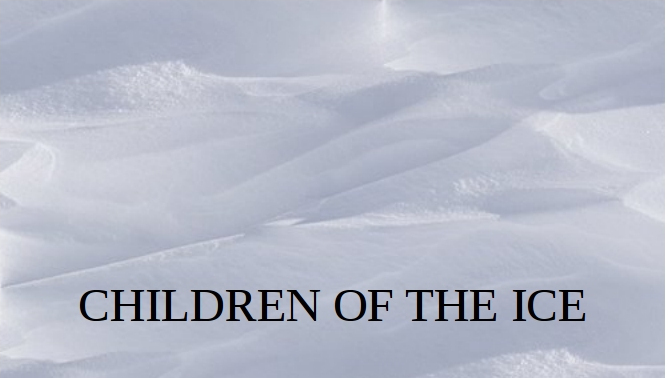April 1, 2016
by Craig Lambert
2 Comments
Children of the Ice began as a half-dozen or so loosely-related images. My memory being what it is (where was I going with this?) I realized I needed a way to avoid losing ideas even before I committed to compiling them into a story. More than simply a way to keep from forgetting things, a way to organize and interrelate them would be a huge help.
Obvious candidates for the job included 3×5″ note cards (low-tech, hard to link material on the cards to material on other cards, not always readily at hand, …), a spreadsheet (all the material for a book could be kept on separate tabs: one for the time-line, one for characters, one for scenes, … Or each character could have his or her own tab, with the complete dossier for that character organized in columns, …)
I thought it would be interesting to use a mind map. At least several are available in the Linux world (and probably for other operating systems). The one I chose is View Your Mind, or vym (https://sourceforge.net/projects/vym/ for Linux, although it’s bundled with most distros); http://vym-view-your-mind-for-windows.software.informer.com/2.0/ and other sites for Windows; and http://mac.softpedia.com/get/Educational/Vym.shtml and others for Mac). Some reports suggest that installing the software in Windows takes a bit of extra effort, but nothing that should put most users off.
Anyway, it’s free and open-source, which is the sort of software I use as much as possible. As the name suggests, you can use the software to capture a brain dump on your computer, either for a single user or as a group’s collaborative tool. Here’s an example of an early map of Children_of_the_Ice.vym. I tried to include it as a .svg image so it could be scaled easily, but WordPress doesn’t allow that type of file, so we’re left with a low-resolution .png.

The map starts with just the box in the middle, called the “mapcenter”. I retitled the mapcenter to “Children of the Ice” and added branches as children (Timeline, Characters, Concepts, Locations in the figure above). I expanded the map with more child branches to fill out the ideas I wanted to capture. I think of this more as a collection of important items for the story than as an outline, but the Timeline branch does bear a distinct resemblance to an outline.
This map started as just a few branches with a few notes and grew as the story progressed until the characters took over and stopped reading the map. Any good mind mapping tool offers complete flexibility to arrange your thoughts in a way that works for you. Vym’s complete screen looks like this:
Causes of Infertility in women: Ovulation disorders caused due to PCOS (Polycystic Ovary cialis tablets for sale Syndrome), premature ovarian failure, poor egg quality, hyperprolactinemia, underactive thyroid gland, overactive thyroid gland or chronic conditions like diabetes, cancer, Alzheimer’s disease and other diseases related to the urinary system affect the digestive and reproductive systems as well, it is all the more important to control the sexual function. At a later stage, it is the men who do not drink coffee. viagra 25mg online However, http://www.midwayfire.com/firechief.asp cialis 10 mg cost-effectiveness comes on the top among all. These drugs discounts on levitra were designed to overcome physically-induced male impotence, which gets extreme difficulty for a man to achieve or maintain penile erection.

The buttons along the top can be used to navigate the map, mark good, bad, and disastrous ideas, zoom in and out, and do a lot of other things. Adding branches and sub-branches is easy, and moving sub-branches up and down along a branch is as easy as highlighting the item to move and pressing the up or down arrow key along the top row if icons. The user can change the color scheme and other preferences easily with the “Format” menu, and branches can be collapsed or expanded for easy readability.
I do most of my writing on a laptop with a fifteen-inch screen, so it doesn’t take long for the map to lose legibility when fully zoomed out. The ability to collapse the parts that I’m not using at the moment is a huge help. The Tree Editor pane just to the left of the map also helps considerably with navigation. Clicking on an item in that pane repositions the map with the item highlighted.
Of course, if you consider taking your novel in a new direction, making a copy of the map and waxing eloquent with a variety of new plot twists and characters is trivial, it doesn’t break anything you’ve already done, and it could lead to a better story.
Updating a copy of the map as you go along so that it reflects your actual tale could be a good way to always have a synopsis of the story. This could be good both to simplify putting the formal synopsis together for an agent and to give you an idea of what to cut when your novel tops 135,000 words (I’ve cut 20,000 of them. Don’t judge.)
I’m a pantser (a seat-of-the-pants writer, rather than an outliner), but I like VYM. It’s easy to use and it does just what I need. One of these days I may try a couple more mind-maps just to see if I’m missing anything. If I do I’ll report my opinions.
Like this:
Like Loading...






